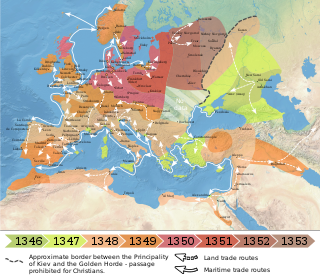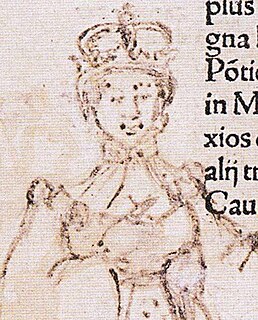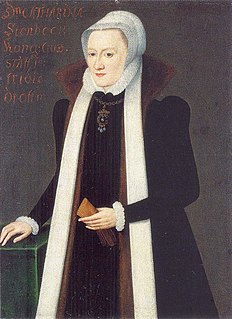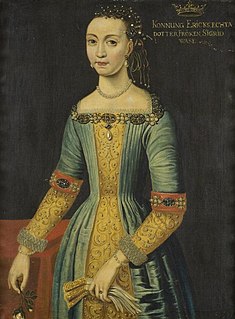Related Research Articles

The Black Death was the deadliest pandemic recorded in human history. The Black Death resulted in the deaths of up to 75–200 million people in Eurasia and North Africa, peaking in Europe from 1347 to 1351. Plague, the disease, was caused by the bacterium Yersinia pestis. The Y. pestis infection most commonly results in bubonic plague, but can also cause septicaemic or pneumonic plagues.

The Great Plague of London, lasting from 1665 to 1666, was the last major epidemic of the bubonic plague to occur in England. It happened within the centuries-long Second Pandemic, a period of intermittent bubonic plague epidemics which originated from Central Asia in 1331, the first year of the Black Death, an outbreak which included other forms such as pneumonic plague, and lasted until 1750.

Karin Månsdotter was first a mistress of King Eric XIV of Sweden and then briefly queen as his wife.
A lady-in-waiting or court lady is a female personal assistant at a court, royal or feudal, attending on a royal woman or a high-ranking noblewoman. Historically, in Europe, a lady-in-waiting was often a noblewoman, but of lower rank than the woman to whom she attended. Although she may either have been a retainer or may not have received compensation for the service she rendered, a lady-in-waiting was considered more of a secretary, courtier or companion to her mistress than a servant.

Catherine Stenbock was Queen of Sweden from 1552 to 1560 as the third and last wife of King Gustav I.

The consequences of the Black Death have had both immediate and long-term effects on human population across the world. These include a series of biological, social, economic, political and religious upheavals which had profound effects on the course of world history, especially the History of Europe. Often simply referred to as "The Plague", the Black Death was one of the most devastating pandemics in human history, peaking in Europe between 1348 and 1350 with an estimated one-third of the continent's population ultimately succumbing to the disease. Historians estimate that it reduced the total world population from 475 million to between 350 and 375 million. In most parts of Europe, it took nearly 80 years for population sizes to recover, and in some areas more than 150 years.

Sigrid Eriksdotter of Sweden was a Swedish princess, the legitimized daughter of King Eric XIV of Sweden and of his lover, later spouse and queen, Karin Månsdotter.

The Black Death was one of the most devastating pandemics in human history, resulting in the deaths of an estimated 75 to 200 million people in Eurasia and peaking in Eurasia from 1321 to 1353. Its migration followed the sea and land trading routes of the medieval world. This migration has been studied for centuries as an example of how the spread of contagious diseases is impacted by human society and economics.

The Black Death in medieval culture includes the effect of the Black Death (1347–1350) on art and literature throughout the generation that experienced it.
Martha Eriksdotter Leijonhufvud, known as Kung Märta, was a politically active Swedish noble. She was the sister of Queen Margaret Leijonhufvud and sister-in-law of King Gustav I of Sweden: she was also the maternal aunt of Queen Catherine Stenbock and the daughter-in-law of the regent Christina Gyllenstierna. In 1568, she financed the deposition of King Eric XIV of Sweden, which placed her nephew John III of Sweden on the throne.
Ebba Eriksdotter Vasa was a Swedish noblewoman. She was the mother of Queen Margaret Leijonhufvud and the second cousin and mother-in-law of King Gustav Vasa.

The Mora witch trials which took place in Mora, Sweden, and Kiruna, Sweden, in 1669, is the most internationally famous Swedish witch trial. Reports of the trial spread throughout Europe, and a provocative German illustration of the execution is considered to have had some influence on the Salem witch trials. It was the first mass execution during the great Swedish witch hunt of 1668–1676.
The second plague pandemic was a major series of epidemics of plague that started with the Black Death, which reached Europe in 1348 and killed up to a half of the population of Eurasia in the next four years. Although the plague died out in most places, it became endemic and recurred regularly. A series of major epidemics occurred in the late 17th century, and the disease recurred in some places until the 19th century. After this, a new strain of the bacterium appeared as the third pandemic.
During the Great Northern War (1700–1721), many towns and areas around the Baltic Sea and East-Central Europe had a severe outbreak of the plague with a peak from 1708 to 1712. This epidemic was probably part of a pandemic affecting an area from Central Asia to the Mediterranean. Most probably via Constantinople, it spread to Pińczów in southern Poland, where it was first recorded in a Swedish military hospital in 1702. The plague then followed trade, travel and army routes, reached the Baltic coast at Prussia in 1709, affected areas all around the Baltic Sea by 1711 and reached Hamburg by 1712. Therefore, the course of the war and the course of the plague mutually affected each other: while soldiers and refugees were often agents of the plague, the death toll in the military as well as the depopulation of towns and rural areas sometimes severely impacted the ability to resist enemy forces or to supply troops.
Gertrud Svensdotter (1656–1675) was a Swedish peasant. She was the witness and accuser in the witch trial against Märet Jonsdotter in 1668, the trial that unleashed the great witch hysteria in Sweden called Stora oväsendet, involving a series of witch trials in many parts of the nation and lasting until 1676.

The status and rights of Women in Sweden has changed several times throughout the history of Sweden. These changes have been affected by the culture, religion and laws of Sweden, as well as social discourses like the strong feminist movement.

Sweden was a country with few witch trials compared to other countries in Europe. In Sweden, hundreds of people were executed for witchcraft prior to the last case in 1704. Most of these cases occurred during a short but intense period; the eight years between 1668 and 1676, when the witch hysteria called "The Great Noise" took place, causing a large number of witch trials in the country. It is this infamous period of intensive witch hunt that is most well-known and explored and given attention.

The Black Death was present in Norway between 1349 and 1350. The Black Death in Norway is more documented than any other Nordic country, but the information is unbalanced and mainly focused on Western Norway.

The Black Death was present in Sweden between 1350 and 1351. It was a major catastrophe which was said to have killed a third of the population, and Sweden was not to recover fully for three hundred years.
The Witch trials in Finland were conducted in connection to Sweden and were relatively few with the exception of the 1660s and 1670s, when a big witch hunt affected both Finland and Sweden. Finland differed from most of Europe in that an uncommonly large part of the accused were men, which was it had in common with the witch trials in Iceland.
References
- ↑ Håkan Welin: Nämndemannen: - uppdrag med förtroende
- Wilhelmina Stålberg: Anteckningar om svenska qvinnor ('Notes on Swedish women') (in Swedish)
| This article about a Swedish lawyer, judge or jurist is a stub. You can help Wikipedia by expanding it. |